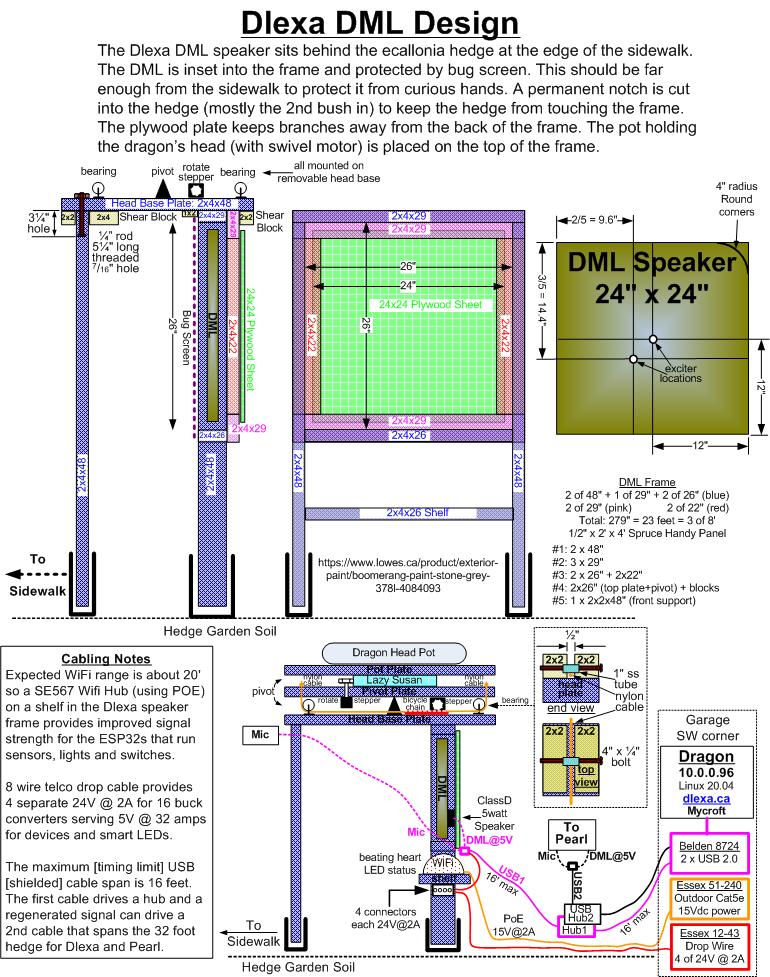 |
      |
| |
Construction Plans and Progress for the Dragon's Hedge Body |
|
This page is in the form of a blog with plans, construction pictures and notes in a chronological order.
You might have to scroll a bit to find what you want.
Dlexa's DML Frame and Cabling Hub
The Dlexa DML speaker sits inside the escallonia hedge at the edge of the sidewalk.
The DML is inset into the frame and protected by bug screen.
This should be far enough from the sidewalk to protect it from curious hands.
A permanent notch is cut into the hedge (mostly the 2nd bush in) to keep the hedge from touching the frame.
The plywood plate keeps branches away from the back of the frame.
The pot holding the dragonís head (with swivel motor) is placed on the top of the frame. A power, cable and WiFi hub
is on the shelf below the speaker.


Frame and Cabling Plans - click to view
Wifi Signal Interference
There are perhaps a dozen microcontrollers in the hedge so RFI and anything that blocks an RF signal is a problem.
ESP family devices (ESP8266, ESP32-CAM, ESP32-S2) are used to manage sound and light effects and they only have one inch square antennas.
Keeping the interference to a minimum and providing a clear signal path requires practices that border on superstition.
Building everything with either wood of plastic helps with the signal paths. Anything metal: frames and boxes
for wiring or electronics can cause reflections and "shadows". Even the longer power and communications cables need to be run on
or under ground. Interconnect wires need to be as thin as possible so the common practice of use thick wires to provide
structural support is a bad idea. To control RFI anything that generates a square wave (buck converters, Vcc to electronics)
needs a capacitor close to the noise source and a ferrite bead on the wire.
Wifi Signal Strength
On Dlexa's DML shelf is an old router. This provides a local strong signal for the controllers. Dean happened to have a box
of old Siemens Gigaset SE567 DSL routers so that was used. [Released 2006, 2.4Ghz 802.11b/g with four 100Mb but you can still buy one].
It is connected via a CAT5e wire into the garage for network/internet access.
Almost any ancient router can be used because the ESP devices are only 2.4Ghz. The ESPs only have a one square inch
antenna and they start having signal problems at 15 feet. Keeping them within 10 feet of an "access point" means fast (for an ESP)
reliable service. With the router 10' from the front of the hedge almost the entire 30 foot dragon is in good signal range.
One Year Plan
In summer 2023 microphones, speakers, cameras and proximity sensors for Dlexa and Pearl will to be mounted on the growing hedge.
At the start the hedge will be "talk only" with audio clips played when a visitor arrives or takes an action (like ringing the gong).
Cameras and microphones will only be monitored for quality.
Providing an end-to-end software loop with Mycroft AI may turn out to be easier than expected. In that case an "Alexa" like experience may be
available by the end of summer. Both Pearl and Dlexa would offer this with "attitude" experience planned for 2024.
Next:
In many cases rough documentation on eyes, ears, voice and light with be posted before their installation with final versions posted after the
effect is operating. The "final" versions may not be the "installed" versions. More of a bridge between what was done and changes planned
for a 2.0 installation.
| | |
 |
| |
| |